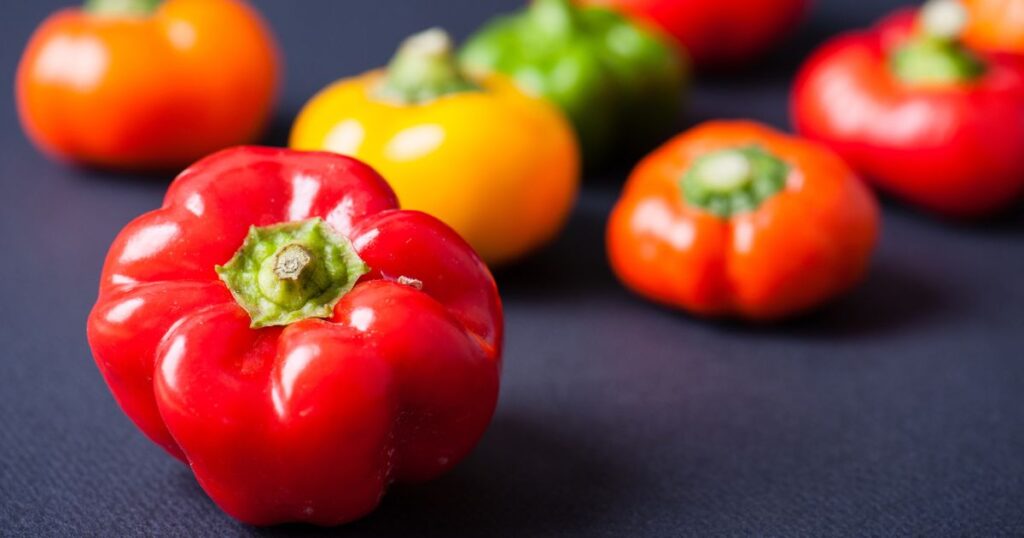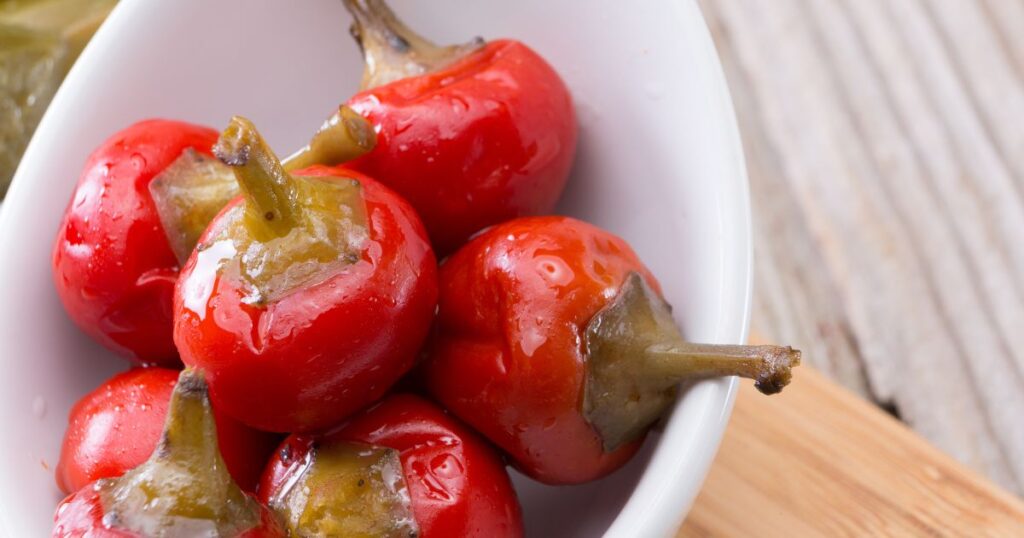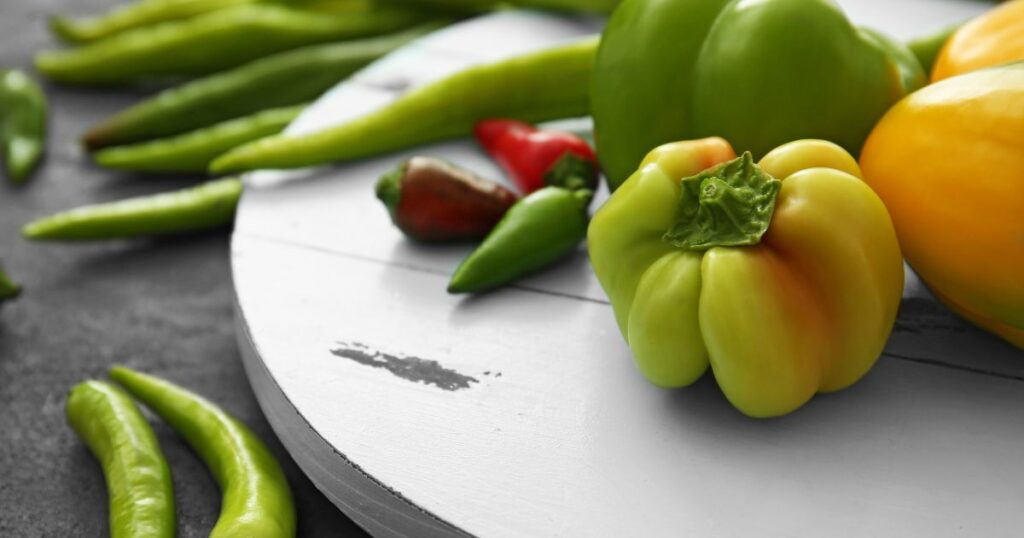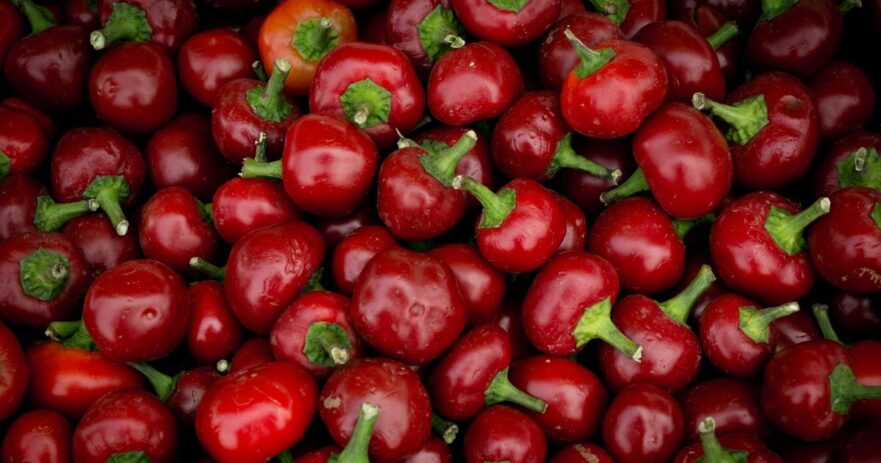In this article about pimento pepper:
🗺️ Origin and history | 🌶️ Uses | ✨ Appearance and taste | 🌶️ Types | 🧑🌾 Growing – gardening | 👨🍳 Cooking – recipes | 🛒 Where to buy | 🫙 How to store | 👨⚕️ Health benefits | 🌶️ Alternatives and substitutes | ❓ Frequently asked questions
What is the pimento pepper?
Pimento peppers, also called cherry peppers or pimiento peppers, are a variety of chili pepper well-known for their sweet, mild flavor and culinary versatility. These small, heart-shaped peppers easily pair with a wide array of dishes without overwhelming the rest of the flavors involved. As a result, pimento peppers have become a popular choice for those seeking a gentler heat to add a little spice to their lives.
| Pimento pepper | |
| SHU | 100 - 500 |
| Median SHU | 300 |
| Flavor | Sweet and mild, succulent |
| Species | Capsicum annuum |
| Origin | Central America and Europe |
| Uses | Stuffed in olives, pimento cheese, salads, etc. |
Are pimento peppers spicy? How hot are they?
Pimento pepper scoville: 100 to 500 SHU
Pimento peppers provide a subtle warmth that caters to a range of spice aficionados and is ideal for those looking for a less intense heat experience. Pimento peppers Scoville rating sits between 100 and 500 Scoville Heat Units (SHU). This places these peppers pretty low on the heat spectrum. To put them in context, compare them to jalapeños, which typically fall between 2,500 and 8,000 SHU. Pimentos are more on par with pepperoncini peppers or heat-free bell peppers.
🗺️ ORIGIN AND HISTORY
Where do pimento peppers come from?
The origin of pimento peppers can be easily traced back to the Caribbean and Central America, where they were first discovered and cultivated. However, over time, their popularity spread across the globe. Today, many pimento pepper varieties actually have European origins and are grown in various regions worldwide.
🌶️ USES
What are pimento peppers good for? How to use them?
These sweet, heart-shaped peppers are perfect for those who like a gentler heat in their meals, and even better, they can be added to a wide array of recipes to satisfy any taste preferences.
One popular use for pimento peppers is stuffing them into olives, which can be found in jars at most grocery stores. Combining the sweet pepper and the briny olive creates a delightful taste sensation that‘s perfect for snacking or adding to antipasto platters. You can also dice up your pimento peppers and toss them into things like pimento cheese, which is a Southern classic.
Pimento peppers are easy to find, which makes them great for adding to whatever you choose. Pimento powder can be used as a seasoning to bring out extra warmth in stews, soups, and even homemade spice blends. Canned pimentos are popular for adding to casseroles or salads for added color and a burst of flavor.
Sliced pimentos are the way to go if you want to add a little flavorful bump to things like sandwiches or pizza. Their vibrant color and mild heat even make them popular for garnishing cocktails!
✨ APPEARANCE AND TASTE

What does a pimento pepper look like?
Pimento peppers are pretty easy to recognize. They’re shaped like hearts and have a vibrant red color. Measuring around 3 to 4 inches, they have smooth skin that’s the perfect thickness to add a fun texture to anything you put them in.
What do pimento peppers taste like?
Pimento peppers have an inviting flavor profile, blending mild heat with a sweet, slightly fruity taste. This makes them a popular choice for adding a touch of warmth to dishes without overwhelming the tastebuds.
Canned pimentos offer a slightly different taste experience. The canning process can actually change their flavor and texture. These pimentos are still sweet and mild, but they’ll now have a somewhat briny flavor as well.
🌶️ TYPES
What are the different types of pimento peppers?
Red pimentos are characterized by their vibrant red hue, heart-shaped appearance, and mild, sweet taste. These peppers are usually used to make pimento cheese or to stuff olives, and their bright color makes them an attractive add-on to various recipes.
Green pimentos are just unripe versions of their more colorful and mature counterparts. They have a milder flavor and a slightly grassy taste, which can make them better for someone looking to experiment with just a tiny bit of pimento in their food.
Now, it‘s important to identify two more varieties of pepper that are often mistaken as types of pimento peppers:
Pimento jamaica, commonly confused with pimento pepper, is actually an entirely different spice. More widely known as Jamaican allspice, it‘s characterized by a rich, complex flavor and plays a significant role in Jamaican cuisine. The berries of the pimento jamaica tree are dried and then used as a primary ingredient in jerk seasoning, lending a distinct, aromatic warmth to various dishes.
Another one to differentiate between is the pimento pepper Trinidad and the pimento pepper. The pimento pepper Trinidad is a Capsicum chinense variety native to Trinidad and Tobago. It boasts all the flavor of scorching peppers like habaneros while delivering almost no heat, making it truly unique. The pimento pepper, on the other hand, is a Capsicum annuum variety.
🧑🌾 GROWING – GARDENING
How to grow pimento peppers?
Pimento peppers are an excellent choice for home gardeners. These peppers flourish in warm climates with plenty of sunshine, making them well-suited for regions with long, hot growing seasons. Pimento peppers can be grown in containers or directly in the ground, with well-drained soil and consistent watering being essential to their successful growth. Regular fertilization throughout the growing season can also contribute to a better harvest.
When to pick pimento peppers?
When it comes to picking pimento peppers, timing is everything. Depending on the variety, they typically take between 70 to 100 days to reach full maturity. The ideal time to harvest is when the peppers have reached their full color of red or yellow.
👨🍳 COOKING – RECIPES

Cooking/Recipe ideas for pimento pepper
People who crave the mild heat and unique flavor of pimento peppers have a huge variety of recipes to choose from!
Stuffed olives with pimento are a classic appetizer and also a fun choice for dropping into martinis. To make these, simply stuff green olives with small strips of pimento pepper. The mild flavor of the pimento pepper works beautifully with the briny tang of the olives, creating a delicious treat.
Stuffed pimento peppers make for a tasty little appetizer or side dish. Hollow out whole pimento peppers and stuff them with cream cheese, herbs, and whatever seasonings your heart desires. Bake them in the oven until tender, and enjoy the blend of flavors and textures.
You can even create a versatile pimento pepper sauce recipe by blending pimento peppers with garlic, onion, vinegar, and a touch of honey. This flavorful sauce can be drizzled over grilled meats and vegetables or even used as a dipping sauce for appetizers.
Lastly, the pimento cheese pepper jelly dip is a highly unique and crowd-pleasing dish. Combine softened cream cheese, grated cheddar cheese, diced pimentos, and a spoonful of pepper jelly in a bowl. Mix until combined and serve with crackers, pretzels, or fresh vegetables for a scrumptious snack.
🛒 WHERE TO BUY
Where can I buy pimento peppers?
If you’re in search of pimento peppers, you can find them at grocery stores in the produce section, usually available fresh or jarred. If fresh pimentos aren’t readily available, try checking specialty food stores or farmer’s markets. Online retailers are another excellent source, as they offer pimento peppers in a range of forms and provide convenient doorstep delivery.
When choosing fresh pimento peppers, look for bright colors and firm textures. Steer clear of peppers that seem wrinkled, soft, or display dark spots, as these may indicate they’re past their prime. For jarred pimentos, make sure the jars are free from damage and have been stored in a cool, dry place.
Where can I buy pimento pepper plants?
If you’re keen on cultivating your pimento pepper plants, you can get one from garden centers or nurseries specializing in vegetable plants. Many online retailers also sell pimento pepper plants that’ll ship right to your home. While selecting plants, prioritize healthy specimens with strong stems and lush green leaves. Steer clear of any plants that appear wilted or have yellow leaves.
Where can I buy pimento pepper seeds?
Pimento pepper seeds can also be found at local garden centers or through online purchases. To grow pimento pepper seeds, follow the guidelines on the seed packet. With proper care and attention, you’ll soon have a flourishing crop of pimento peppers to enjoy.
🫙 HOW TO STORE
How do I store pimento peppers?
Pimento peppers can stay fresh for up to two weeks when stored correctly. To keep them, put the peppers in a plastic bag or a sealed container and place them in the crisper drawer of your refrigerator. This helps maintain their freshness and extends their shelf life.
As with any other fresh produce, pimento peppers can go bad if they’re not stored properly or have passed their prime. Spoilage indicators include soft or wrinkled skin, mold, or a funky odor. It’s important to toss out any pimento peppers showing these signs to ensure food safety.
Canned or jarred pimento peppers can last in the refrigerator for a few months. To store these, keep the peppers in their original jar or transfer them to an airtight container and pop them into the refrigerator. Make sure the container is tightly sealed to avoid spoilage.
Can pimentos be frozen?
Yes, pimento peppers can be frozen for extended storage. To freeze them, wash the peppers thoroughly and remove the stems and seeds. Arrange the peppers in a single layer on a baking sheet and freeze for several hours. Once frozen, transfer the peppers to an airtight container or plastic freezer bag and store them in the freezer for up to six months. This allows you to enjoy pimento peppers in your dishes even when they’re out of season.
❤️🩹 HEALTH BENEFITS
Are pimento peppers healthy?
Pimento peppers are not only delicious but also provide a nice range of health benefits. They‘re low in calories, high in fiber, and rich in essential vitamins such as C, A, and B6. The high vitamin C content in pimento peppers may help to boost the immune system, promote healthy skin, and support overall well-being.
In addition to their vitamin content, pimento peppers contain a compound called capsaicin. Capsaicin is known for its anti-inflammatory, pain-relieving, and metabolism-boosting properties. Pimento peppers, being milder, can be an excellent option for those who want to enjoy the health benefits of capsaicin without the intense heat.
🔄 ALTERNATIVES AND SUBSTITUTES

What’s a good pimento pepper alternative?
There are plenty of options that can provide many of the same uses found with pimento peppers if you’re looking for an alternative.
Bell peppers are popular for people who want no heat at all but still want a similar flavor profile. Like pimento peppers, bell peppers are sweet and can be found in various colors. In addition, they share a similar texture and can be used in a wide range of recipes, such as salads, stir-fries, or stuffed with various ingredients.
Banana peppers can be another good option to choose from. These peppers have a mild heat and tangy, slightly sweet taste that works well in salads, sandwiches, and pickling recipes.
Pronunciation:
Pimento peppers are pronounced pi-MEN-toh.
🙋 FREQUENTLY ASKED QUESTIONS
FAQ about pimento peppers
Are pimento peppers spicy?
Pimento peppers are not considered spicy; they‘re known for their sweet and mild flavor. On the Scoville heat scale, pimento peppers rank between 100 and 500 units, making them one of the least spicy chili peppers available.
Can you grow pimento peppers in pots?
You sure can! These peppers are suitable for container gardening as long as you provide them with well-drained soil, sufficient sunlight, and consistent watering. Choose a pot with drainage holes at least 12 inches in diameter to ensure the plant has enough space to grow.
Pimento seeds vs. black pepper - What's the difference?
Pimento seeds and black pepper are distinct spices with unique flavors and culinary applications. Pimento seeds are derived from the pimento jamaica tree, also known as Jamaican allspice, and not from pimento peppers. This spice imparts a rich, complex flavor and is integral to Jamaican cuisine. The dried berries are primarily used in jerk seasoning, adding a distinctive, aromatic warmth to various dishes. On the other hand, black pepper comes from the Piper nigrum plant and features a sharp, spicy taste, commonly used as a seasoning in many recipes. Although both spices enhance the flavor of dishes, their contrasting taste profiles make them non-interchangeable.
How long do pimento peppers take to mature?
Pimento peppers typically take around 70 to 100 days to reach full maturity from the time of planting. This‘ll vary depending on climate, soil conditions, and overall plant health. The peppers can be harvested when they have reached their full size and developed a deep red color. Regularly picking ripe pimento peppers encourages the plant to keep producing fruit throughout the season.

